September 14, 2010 at 3:38 pm
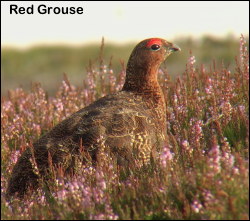
This is one Red Grouse that has survived the glorious twelfth. The heather has been so purple this year that I couldn’t resist a trip to the Northern Dales this week to obtain a last clip of video before I start work scripting the new Pennine DVD. There were grouse everywhere and it was obvious that they have had a good breeding season with dry, warm weather in the crucial April/May period.
On a recent trip into Rochdale and Oldham we saw from the car two Sparrowhawks, two Buzzards, one Peregrine and one Kestrel not a bad total for a fifteen minute round trip.
The Swallow roost has now broken with only fifty birds present on the second of September, down from up to five thousand the day before. In the garden a female Sparrow Hawk has appeared and made a kill today flying off with its prey before I could come to the rescue!
September 4, 2010 at 3:31 am
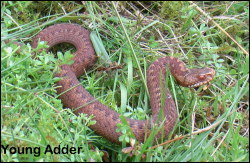
Whilst looking for Hobbies I came across this young Adder. It is about six weeks old and six inches long and I believe it can still give you a lethal bite despite its age. Apparently August is the month when young Adders emerge and they are on their own as soon as they are born.
The Swallow roost continues to impress at more than two thousand birds per night and no predation yet from any raptors. I would expect their numbers to reduce soon as the movement South starts in earnest in September. I wonder how many will reach South Africa and return next year?
August 28, 2010 at 9:44 pm
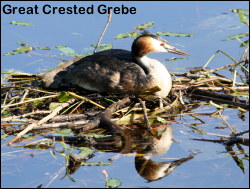
More time has been spent this week looking for Hobbies but all to no avail. I have now given up all hope of including one in this years Pennine DVD so we will have to settle for fourteen species of raptor on it and not fifteen!
It was however pleasing whilst in Macclesfield forest to see that some pairs of Great Crested Grebes still had young.
Hopwood has starred this week with a record of fifty two Mistle Thrushes present on the 26th and a Kingfisher on the 22nd. Both Buzzard and a male Blackcap have also been seen during the week. At the same time there are still two broods of Swallows in the nest at the golf club adding to the more than fifty young that have fledged there this year.
In the garden we have had a record seven Chaffinches on the 24th and some nights a Tawny Owl has been present. On the 24th it was a full moon and we lay in bed watching the clouds scurry across the moon at midnight awaiting the arrival of the Tawny Owl but of course it did not show up that night.
August 21, 2010 at 7:02 pm
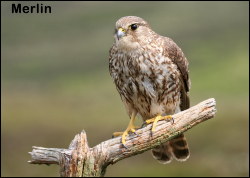
On three good days this week I spent time in the Goyt Valley and on the Staffordshire moorlands looking for Hobbies. Only a female Merlin was seen, which in itself is always a good bird sighting but not what I was looking for! According to the bird press Kestrels are down in number by 53 percent in the last two years due mainly to the two,hard Winters that we have had. Well on one day alone I saw fourteen different Kestrels and as most were young birds they will be a welcome addition to the falling population.
The Swallow roost that I have been watching has now increased to more than a thousand birds as the young birds fledge and join the the existing Swallows that are beginning to head South. I obtained some good video of them against the rising moon on the only night the moon was visible.
On Hopwood on the nineteenth was a record flock of forty Mistle Thrushes feeding on rowan berries. A Whitethroat was still giving alarm calls by a bramble indicating late breeding.
August 15, 2010 at 10:43 am
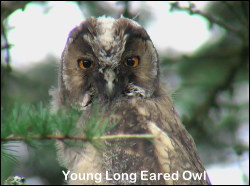
With only its ear tufts to grow this young Long Eared Owl looks very much like an adult. By now it is well able to catch prey for itself and will soon be driven away from the nesting area and will have to look for a wood of its own. There will be many more doing the same in the next few months as they have had an exceptional breeding season which is good news for us as it is always a good day when you find a roosting Long Eared Owl.
Whilst watching Barn Owls a few nights ago at dusk I found a field of maize that was being used as a roosting place for five hundred plus Swallows. It is a long time since I watched Swallows roosting but it is still an exciting sight and to think that this field is just one staging post for their migration to South Africa. Forty years ago this month I was part of a group that caught and ringed more than five thousand Swallows in the reed beds near Wigan. We had many of those birds recovered in South Africa. The sound of Swallows gathering at dusk always brings back good memories of those nights at Wigan. The only difference being that on those occasions there were more than ten thousand birds present each night!
In the garden there are still family parties of Goldfinches coming to feed. Some of the young have only just fledged the nest.
August 7, 2010 at 2:52 pm
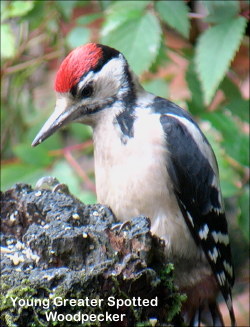
Here is a photo of the young Greater Spotted Woodpecker that visits our garden on its own, now that it has been abandoned by the adults.During the week the Collared Dove record has gone up to twenty feeding together. What is it going to finish at?
In a moorland plantation I heard my only young Sparrowhawks this year begging for food. I understand they are down in number this year and this is the first year for decades that I have failed to find a nest. Three young Dabchicks were a late brood to find especially as this pair had their first nest in April and have had a very successful breeding season despite severe disturbance from youths swimming in their pool in the hot weather on May and June.
On Hopwood a Green Woodpecker called during the week and yet again a year goes by without any proof of their breeding. It was good to hear Goldcrest in the pines but are they local breeding birds or early migrants from Scandinavia? The Sand Martins and Swallows are still producing young with most having had second broods despite the recent poor weather.




